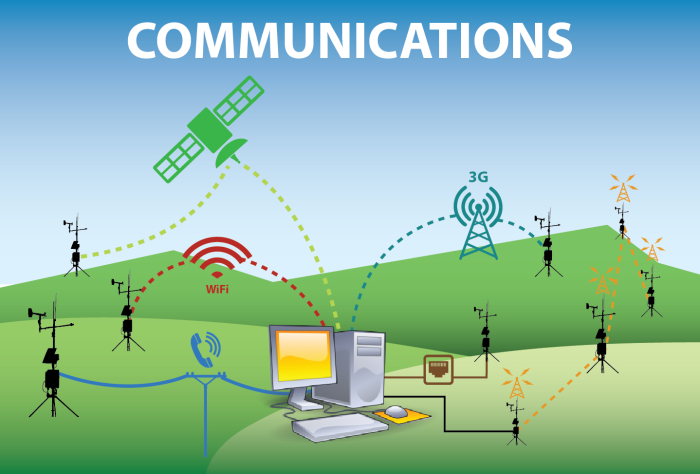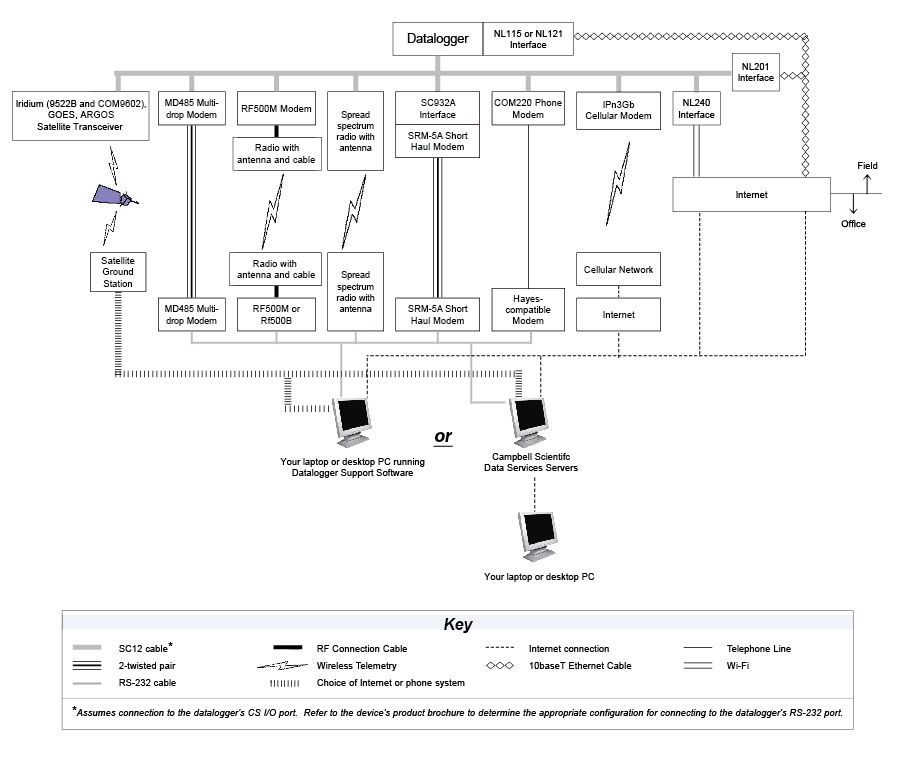
When designing a monitoring system, you need to consider how you will get the data from the station’s datalogger to your PC. The communications device you choose will greatly depend on the location of your station, as well as the frequency and size of your data. We are highly experienced in providing various communications components as well as data management services for each type of communication device.
Go to section:
Communications device or Data Services?
Remote Communications Telemetry Options
Communications device or Data Services?
There are four ways to get data from your station.
- Outsource data collection and delivery to our Data Services department
- Transmit data from a remote station site to your office PC using a telemetry device
- Retrieve data during an onsite visit
- All of the above
To determine the best data storage and retrieval method for your application, you should consider:
- Availability of resources — determine if you can handle data collection, storage, display, reporting, QA/QC, monitoring the system to ensure everything is working as expected, etc. with the in-house resources you have available.
- Accessibility of Site — a dependable telemetry solution that transmits data to a base station’s computer is preferable for a site that is difficult to access. On the other hand, if your site is essentially in your backyard, you may want to collect data with a portable handheld device or laptop.
- Availability of Service — prior to the purchase of any equipment, you should determine if the appropriate coverage for cellular, RF, or satellite systems is available for your site. The use of telephones or the Internet requires that phone lines or an Internet connection be available within a few miles of the site.
- Quantity of Data Collected — this affects the transmission duration. For some telemetry devices, a long transmission length will significantly impact the current drain, and perhaps service costs.
- Frequency of Data Collection — if you need near real-time data, a telemetry device is indicated. If you only need to collect data every few weeks, you may prefer an on-site device. A good rule-of-thumb is that you should retrieve your data at a frequency that you can afford to lose it. For example, when retrieving data manually, you never know what happens at your site until you return the next time. If a bear was to tear out a cable 10 minutes after you leave and you do not return for 3 months, you have just lost 3 months of data that can not be replaced!
Telemetry Options
Remote Communications Telemetry Options
| Type of communication | General | Application Requirements/Constraints | Products | Data Management Services Available |
|
Telephone (land-line) |
Transmits data over phone land-lines
|
|
 |
|
|
Cellular |
Transmits data over cellular network to cell tower. Data can be accessed through the Internet via TCP/IP protocol or an IP address.
|
|
 Plus Cell Service Options:
|
|
|
Short-haul Modem |
Hard-wired connection |
|
|
|
|
Multi-drop |
|
|
||
|
Radio Frequency (RF Networks) |
UHF/VHF Narrowband
|
|
|
|
|
Spread-spectrum
|
|
RF432 |
|
|
|
Internet and IP Networks |
Ethernet
|
|
|
|
|
Wi-fi
|
|
|
||
|
Satellite |
GOES
|
|
|
|
|
ARGOS
|
|
|
||
|
Iridium (RUDICS or dial-up)
|
|
Plus Iridium Service Options:
|
||
|
Short Burst Data (SBD) Modem (on Iridium network)
|
|
Plus Iridium SBD Service Options:
|
Detailed comparisons of product specifications and compatibility can be found in the Data Storage and Retrieval Peripherals Brochure.
Software Support
If you are doing your own collections, you will need software on your computer. Our PC200W software is available, at no charge, from our website; it supports direct communications only. PC400, RTDAQ, and LoggerNet software support our direct and telemetry options. LoggerNet also supports scheduled data collection and combining data retrieval methods (e.g., phone-to-radio).
Combining Options
You can increase the flexibility, convenience, and reliability of your application’s data storage and retrieval by combining an on-site device with a telemetry device. For example, cellular phone with on-site back-up provided by a CompactFlash card combines an on-site and telemetry device. You can also combine two telemetry methods. Popular telemetry combinations are Ethernet-to-radio and phone-to-radio.







